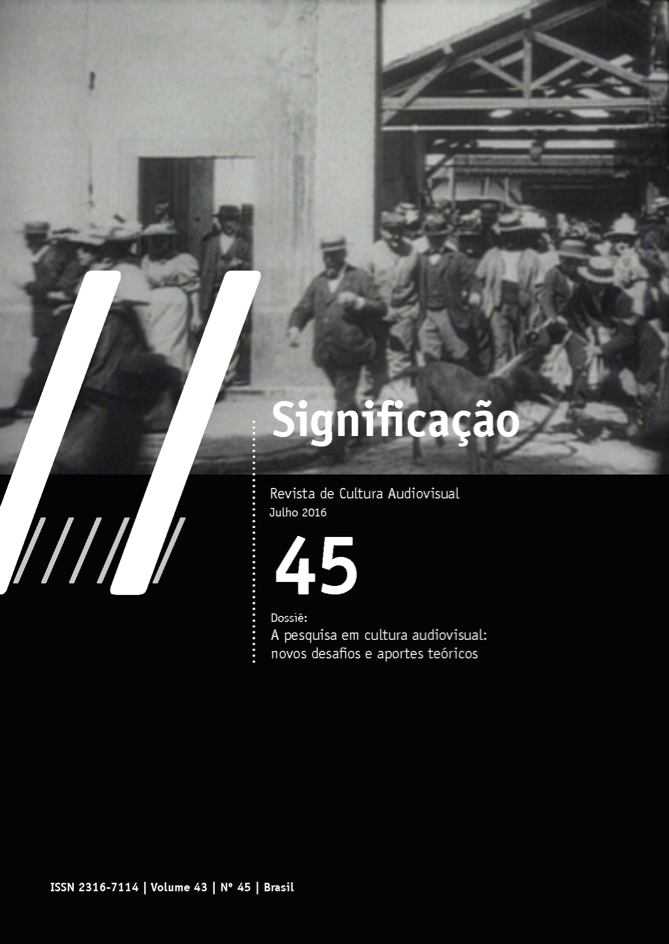The interesting image: cinema and narrative halt
DOI:
https://doi.org/10.11606/issn.2316-7114.sig.2016.110850Keywords:
Cinematographic narrative, Narrative halt, Cinematographic imageAbstract
This article intends to investigate when and in what way, by which criteria and how accurately can one affirm that there has been a “narrative halt”, what are the qualities of the images that promote such halt and what are its consequences on the viewer’s experience. For that matter, we will articulate several different notions – the “extended concept of moving-picture dance” (Carroll), “photogeny” (Epstein, Xavier), the “musical number” (Altman, Sutton), the “cinema of attractions” (Geaudreault, Borges), the “punctum” and the “third sense” (Barthes) and the “cinematic excess” (Thompson) – and we will suggest that, by rejecting the motivations and the causality of the plot, this image that is “interesting for its own sake” ultimately reveals a certain “elasticity” within cinema’s narrative itself.
Downloads
References
ALTMAN, R. “The American film musical as dual-focus narrative”. In. The American film musical. Bloomington-Indianapolis: Indiana University Press, 1987, p. 16-27.
BARTHES, R. A câmara clara. Rio de Janeiro: Nova Fronteira, 1984.
BARTHES, R. “O terceiro sentido”. In. O óbvio e o obtuso. Rio de Janeiro: Nova Fronteira, 1990, p. 45-61.
BORDWELL, D. Narration in the fiction film. Madison: University of Wisconsin Press, 1985.
BORGES, C. “Da pose fotográfica à passagem cinematográfica: fundamentos da imagem fotossensível”. Significação, nº 35, 2011, p. 153-167.
BORGES, C. “Mais perto do coração selvagem (do cinema)”. In. GONÇALVES, O. (org.). Narrativas sensoriais: ensaios sobre cinema e arte contemporânea. Rio de Janeiro: Circuito, 2014, p. 41-59.
CARROLL, N. “Toward a definition of moving-picture dance”. Dance research journal, 33/1, verão de 2001, p. 46-61.
EPSTEIN, J. “Le cinématographe vu de l’Etna”. In. Écrits sur le cinéma, tome 1: 1921-1947. Paris: Éditions Seghers, 1974, p. 131-168.
GAUDREAULT, A. Film and attraction: from kinematography to cinema. Chicago/Springfield: University of Illinois Press, 2011.
GAUDREAULT, A, e JOST, F. A narrativa cinematográfica. Brasília: Editora UnB, 2009.
HEATH, S. “Film and system: terms of analysis – part I”. Screen, vol. 16, nº 1, primavera de 1975, p. 7-77.
MALABOU, C. “Plasticité surprise”. In MALABOU, C. (org.). Plasticité. Paris: Léo Scheer, 2000, p. 310-323.
MULVEY, L. Death 24x a second. Londres: Reaktion Books, 2006.
SUTTON, M. “Patterns of meaning in the musical”. In. ALTMAN, R. (org.). Genre: the musical. Cambridge: Cambridge University Press, 1993, p. 103-126.
THOMPSON, K. “The concept of cinematic excess”. Ciné-tracts, nº 2, verão de 1977, p. 54-63.
XAVIER, I. “Do ritmo à fotogenia”. In. Sétima arte: um culto moderno. São Paulo: Perspectiva, 1978, p. 79-102.
Downloads
Published
Issue
Section
License
Copyright (c) 2016 João Vitor Resende Leal

This work is licensed under a Creative Commons Attribution-NonCommercial 4.0 International License.
Authors who publish in this journal must agree with the following terms:
- Authors keep their copyrights and grant the journal first time publication rights, having their articles simultaneously licensed under the Creative Commons Attribution License, which allows sharing texts with authorship recognition and first publication on this journal for non-commercial purposes.
- Authors are allowed to make additional contracts, for a non-exclusive distribution of the article’s version published on this journal (e.g.: publishing in institutional repositories of articles or as a book chapter), with authorship recognition and first publication on this journal.
















